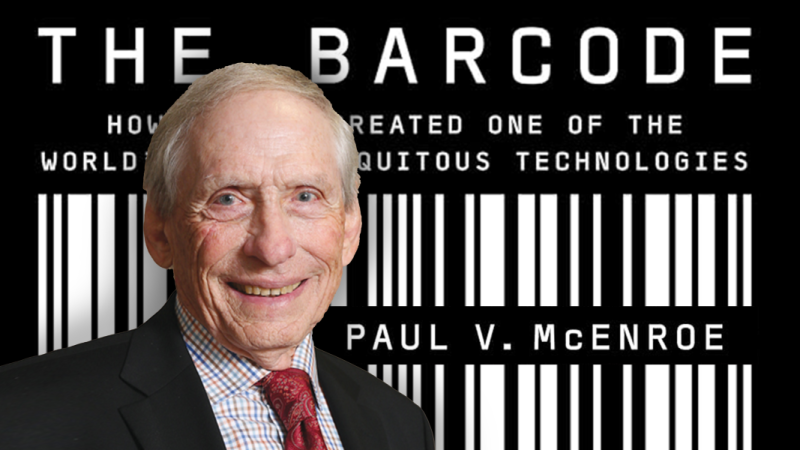Dinis Guarda Discusses The Development Of Barcode Technology With Inventor Paul McEnroe

Categories :
Dinis Guarda interviews the award-winning engineer and the developer of the Universal Product Code (UPC), also known as the barcode, Paul McEnroe. In this episode of Dinis Guarda YouTube podcast, the two discuss the development and evolution of the revolutionary technology of barcodes, and how the data generated with this technology became the basis of the modern generation of emergent technologies. The podcast is powered by openbusinesscouncil.org and citiesabc.com.
A former group director at IBM, Paul McEnroe was part of the team pioneering the development of the Universal Product Code (UPC), also known as the barcode, marking a groundbreaking commercial application of laser technology, barcode scanning, and magnetic Stock Keeping Unit (SKU) coding.
Paul wrote the memoirs of this development and the anecdotes of the journey in his book, "THE BARCODE: How a Team Created One of the World's Most Ubiquitous Technologies," published by Silicon Valley Press in Fall 2023.
Early in the interview, Paul tells Dinis that the initial idea of developing the technology was to build up an innovation that would promote the computational skills of computers and related technologies prevalent during the early 1960s. The final product, the Barcode, was a result of many years of innovation and research work done by a team of 7 engineers at IBM.
The barcode technology, he said, suffered resistance during its early days, both from retailers and government. Narrating one of the customer experiences, he said Barcode actually gave the consumer the liberty to compare pricing and transparency in systems.
“In 1973, 20 years ago, it was selected as an international standard”, he said. “That was when we realized that technology is going to have an impact on the world. We did think that it was going to control the supermarkets and specific retail stores, hypermarkets, and hotels and motels, but it wasn’t until the early 80s that we really saw it growing big and controlling a lot.”
The reliable and convenient nature of bar codes
Barcodes are graphical representations of data, typically a series of numbers or alphanumeric characters. These codes are created using a combination of black bars and white spaces, with each sequence representing a specific set of information.
During the interview, Paul explained the technical flow of information from a barcode sequence into a readable format. He also highlighted the evolution of technology from the first barcode, resembling a bullseye, invented by Norman Joseph Woodland and Bernard Silver to the development of the Universal Product Code (UPC), a familiar sight on nearly every retail product today.
“Consider the car that you are sitting in. All the components of that car have little bar codes on it, and they get scanned. Putting those few assemblies together gives a track of every component of the car you hold. These bar codes help in manufacturing, the automation, and the control, to finally get a new car.
That creates the reliability and convenience that a customer needs.”
He further told Dinis that the technology faced resistance during its early days, both from the labour unions and the governments. One particular resistance came from the use of lasers, used in scanning of the bar code.
A barcode scanner, also known as a barcode reader or scanner, uses a laser light source to read the code. When the scanner's light beam hits the barcode, it reflects back into a light-detecting sensor, converting the pattern of light and dark bars into a readable digital format.
But, as a technologist himself, he explained how the team at IBM proved it through an extensive research that “you could not hurt with only half a watt lasers, that was there in the supermarkets. So, after a few years, all those things fizzed away.”
Bar Codes: An effective tool to generate volumes of data
The true power of barcodes lies in their versatility and adaptability across numerous industries. This adaptability ensures that barcodes can seamlessly integrate into various workflows, enabling the gathering of vast amounts of data across different sectors.
Speaking about the idea behind the bar code technology, Paul told Dinis that as part of the innovation culture of IBM, the team developed an application “that is going to sell more computers and hence create data for computation.”
Whether it's tracking products in the retail sector, managing inventory in logistics, monitoring patient data in healthcare, maintaining the arms and ammunition inventory in the military, or cataloging books in libraries, barcodes provide a standardized and efficient way to capture and store information.
Their universal application means that a single technology can be harnessed to accumulate data on a massive scale, contributing to the efficiency, accuracy, and transparency of operations in countless fields.
“We created so many bits in the supermarket application that we had to develop not only a new communication system which became a Token Ring Local Area Network (LAN), but we also had to change the basic recordings.”
Paul also told Dinis that they were using a prototype of the modern day AI, primarily to read through the data and make informed “guess”. However, he says that the present iteration of technologies certainly can handle increased volumes of data with better accuracy and enhanced features.
“It’s going to be amazing where it goes. We are going to have to be very smart and careful about how to apply it”, he said.
Modern day innovation in the bar code technology
Barcodes have come a long way from their origins as a simple tool for automating the checkout process in grocery stores. In today's digitally transformed world, barcode technology continues to evolve and adapt to the ever-increasing demands of various industries.
The transition from 1D to 2D barcodes, exemplified by QR codes, has expanded their data storage capacity, making them invaluable for marketing, ticketing, and payments. Enhanced security measures have made barcodes integral to ensuring product authenticity in industries like healthcare.
Speaking about the continued relevance of bar code in this dynamic scenario of innovations and evolution in this area, Paul told Dinis that the bar code technology will keep going to be used as the primary code of use, especially in areas that need only a few digits.
“Because it is inexpensive, so widely used, and without any royalties, I don’t think any innovation can replace the bar code itself. Although, I do think there is going to be a boom in QR codes and RFIDs, and other such innovations.”
He explained that the QR codes have become ubiquitous, driving engagement and interactivity with consumers through their smartphones. Furthermore, radio-frequency identification (RFID) technology has emerged as a powerful complement to barcodes, offering real-time tracking and advanced inventory management capabilities. Together, these technologies represent a dynamic and adaptable toolkit for businesses and organizations, enabling them to thrive in a data-centric, interconnected world while also addressing sustainability concerns.

With a driving passion to create a relatable content, Pallavi progressed from writing as a freelancer to full-time professional. Science, innovation, technology, economics are very few (but not limiting) fields she zealous about. Reading, writing, and teaching are the other activities she loves to get involved beyond content writing for intelligenthq.com, citiesabc.com, and openbusinesscouncil.org








